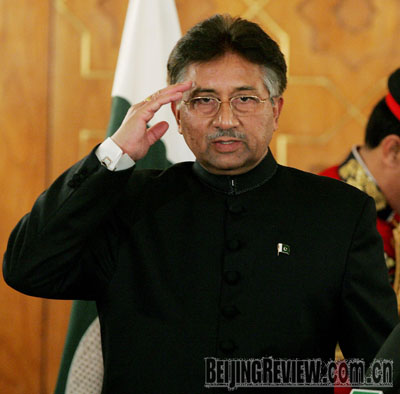| 
FAREWELL: A file photo of former Pakistani President Pervez Musharraf, who resigned on August 18
Recently, Pakistan had a political earthquake. On August 18, President Pervez Musharraf announced his resignation in a nationally televised speech. After the Pakistani Parliament accepted his resignation, the 57-year-old Speaker of the Pakistan Senate, Muhammadmian Soomro, became acting president in accordance with Pakistan's Constitution. Lawmakers must select a new president within 30 days.
Pakistan, an important ally of the United States, is now at a crucial point in the war on terror. Some Western media worry that Musharraf's resignation might further decentralize power inside Pakistan, leading to political disintegration in the country. The two largest political parties-the Pakistan People's Party (PPP) and the Pakistan Muslim League (Nawaz), or PML-N, led by former Prime Minister Nawaz Sharif-formed a multi-party coalition government in February, united in their opposition to Musharraf's rule. But the two parties disagree on how to fight extremism and terrorism, while lacking experience in this field. Sharif withdrew his party from the coalition on August 25, citing the PPP's reversal on reinstating judges dismissed by Musharraf. Although the coalition government will stay in place, it now has a powerful opponent-Sharif.
Reasons behind
There were several reasons behind Musharraf's resignation. Huge political pressure from the ruling alliance left him with little choice, especially after the PPP and PML-N agreed to pursue impeachment. Even before his opponents won the parliamentary election in February, Musharraf's situation was precarious. He faced strong criticism from exiled politicians abroad and a growing pro-democracy movement at home. As the Taliban and Al Qaeda militants in the Pakistan-Afghanistan border region grew stronger, the United States pushed him to be more aggressive and began to value him less as an asset in the war on terror. Musharraf kept an uneasy hold on power.
After the election, it was Sharif who led the calls for Musharraf to resign. The two men have a rancorous relationship. Musharraf ousted Sharif in 1999. Sharif worked to drive Musharraf from office while in exile before returning to Pakistan in November 2007. In recent months, Sharif threatened to pull the PML-N from the coalition unless PPP leader Asif Ali Zardari agreed to seek Musharraf's impeachment. On August 7, the government gave Musharraf an ultimatum: request a vote of confidence or face impeachment proceedings. Then, three of Pakistan's four provincial parliaments passed resolutions publicly condemning the president for violating the constitution. Musharraf was besieged on all sides, thus he had no choice but to step down.
|
